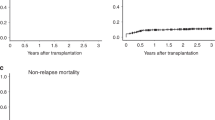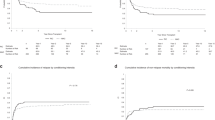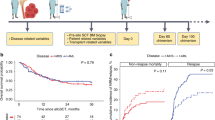Abstract
We studied outcomes of 65 consecutive patients with therapy-related AML/myelodyplastic syndrome (t-AML/MDS) who underwent allogeneic hematopoietic cell transplantation (HCT). Previously published scores of HCT-CI, CIBMTR, EBMT and Comorbidity-age index were also evaluated. Median follow-up of survivors was 72 months (range 16–204). At 2 years, overall survival (OS) was 34% (95% confidence interval (CI) 23–45). Nineteen patients (29%) had monosomal karyotype (MK). Patients with MK had an OS of 21% (95% CI 7–41) at 2 years. Abnormal adverse cytogenetics, unrelated donor, bone marrow graft and CIBMTR score were significant risk factors for OS on univariate analysis. On multivariate analysis, abnormal adverse cytogenetics (hazard ratio (HR) 2.7; 95% CI 1.02–7.2; P-value=0.02) and unrelated donor (HR 2.7; 95% CI 1.5–5.0; P-value=0.0013) were independent factors for survival. Non-relapse mortality (NRM) at 2 years was 31% (95% CI 15–47). Donor type was the only factor that was significant for NRM with matched related donors having an NRM of 20% (95% CI 0–42) whereas unrelated donors had NRM of 60% (95% CI 40–80; P-value=0.0007). In conclusion, patients with t-AML/MDS have poor OS. Unrelated donor is a significant risk factor for both higher NRM and decreased OS. Cytogenetics are predictive for OS.
This is a preview of subscription content, access via your institution
Access options
Subscribe to this journal
Receive 12 print issues and online access
$259.00 per year
only $21.58 per issue
Buy this article
- Purchase on Springer Link
- Instant access to full article PDF
Prices may be subject to local taxes which are calculated during checkout


Similar content being viewed by others
References
Vardiman JW, Thiele J, Arber DA, Brunning RD, Borowitz MJ, Porwit A et al. The 2008 revision of the World Health Organization (WHO) classification of myeloid neoplasms and acute leukemia: rationale and important changes. Blood 2009; 114: 937–951.
Curtis RE, Boice JD Jr, Stovall M, Bernstein L, Holowaty E, Karjalainen S et al. Relationship of leukemia risk to radiation dose following cancer of the uterine corpus. J Natl Cancer Inst 1994; 86: 1315–1324.
Ratain MJ, Kaminer LS, Bitran JD, Larson RA, Le Beau MM, Skosey C et al. Acute nonlymphocytic leukemia following etoposide and cisplatin combination chemotherapy for advanced non-small-cell carcinoma of the lung. Blood 1987; 70: 1412–1417.
Curtis RE, Boice JD Jr, Stovall M, Bernstein L, Greenberg RS, Flannery JT et al. Risk of leukemia after chemotherapy and radiation treatment for breast cancer. N Engl J Med 1992; 326: 1745–1751.
Eichenauer DA, Thielen I, Haverkamp H, Franklin J, Behringer K, Halbsguth T et al. Therapy-related acute myeloid leukemia and myelodysplastic syndromes in patients with Hodgkin lymphoma: a report from the German Hodgkin Study Group. Blood 2014; 123: 1658–1664.
Fisher B, Rockette H, Fisher ER, Wickerham DL, Redmond C, Brown A . Leukemia in breast cancer patients following adjuvant chemotherapy or postoperative radiation: the NSABP experience. J Clin Oncol 1985; 3: 1640–1658.
Koontz MZ, Horning SJ, Balise R, Greenberg PL, Rosenberg SA, Hoppe RT et al. Risk of therapy-related secondary leukemia in Hodgkin lymphoma: the Stanford University experience over three generations of clinical trials. J Clin Oncol 2013; 31: 592–598.
Traweek ST, Slovak ML, Nademanee AP, Brynes RK, Niland JC, Forman SJ . Clonal karyotypic hematopoietic cell abnormalities occurring after autologous bone marrow transplantation for Hodgkin's disease and non-Hodgkin's lymphoma. Blood 1994; 84: 957–963.
Mailankody S, Pfeiffer RM, Kristinsson SY, Korde N, Bjorkholm M, Goldin LR et al. Risk of acute myeloid leukemia and myelodysplastic syndromes after multiple myeloma and its precursor disease (MGUS). Blood 2011; 118: 4086–4092.
Kayser S, Dohner K, Krauter J, Kohne CH, Horst HA, Held G et al. The impact of therapy-related acute myeloid leukemia (AML) on outcome in 2853 adult patients with newly diagnosed AML. Blood 2011; 117: 2137–2145.
Kern W, Haferlach T, Schnittger S, Hiddemann W, Schoch C . Prognosis in therapy-related acute myeloid leukemia and impact of karyotype. J Clin Oncol 2004; 22: 2510–2511.
Abdelhameed A, Pond GR, Mitsakakis N, Brandwein J, Chun K, Gupta V et al. Outcome of patients who develop acute leukemia or myelodysplasia as a second malignancy after solid tumors treated surgically or with strategies that include chemotherapy and/or radiation. Cancer 2008; 112: 1513–1521.
Feng R, Liu H, Chang N, Fan Y, Li J, Zhang Y et al. Monosomal karyotype among adult acute myeloid leukemia: clinical characteristic and prognostic analysis. Zhonghua Xue Ye Xue Za Zhi 2014; 35: 393–396.
Kayser S, Zucknick M, Dohner K, Krauter J, Kohne CH, Horst HA et al. Monosomal karyotype in adult acute myeloid leukemia: prognostic impact and outcome after different treatment strategies. Blood 2012; 119: 551–558.
Breems DA, Van Putten WL, De Greef GE, Van Zelderen-Bhola SL, Gerssen-Schoorl KB, Mellink CH et al. Monosomal karyotype in acute myeloid leukemia: a better indicator of poor prognosis than a complex karyotype. J Clin Oncol 2008; 26: 4791–4797.
Litzow MR, Tarima S, Perez WS, Bolwell BJ, Cairo MS, Camitta BM et al. Allogeneic transplantation for therapy-related myelodysplastic syndrome and acute myeloid leukemia. Blood 2010; 115: 1850–1857.
Kroger N, Brand R, van Biezen A, Zander A, Dierlamm J, Niederwieser D et al. Risk factors for therapy-related myelodysplastic syndrome and acute myeloid leukemia treated with allogeneic stem cell transplantation. Haematologica 2009; 94: 542–549.
Alam N, Marras TK, Atenafu EG, Gupta V, Kuruvilla J, Lipton JH et al. Allogeneic peripheral blood stem cell transplantation significantly increases risk of chronic graft-versus-host disease of lung compared with bone marrow transplantation. Biol Blood Marrow Transplant 2012; 18: 1905–1910.
Alam N, Atenafu EG, Tse G, Viswabandya A, Gupta V, Kim D et al. Limited benefit of pentostatin salvage therapy for steroid-refractory grade III-IV acute graft-versus-host disease. Clin Transplant 2013; 27: 930–937.
Grimwade D, Hills RK, Moorman AV, Walker H, Chatters S, Goldstone AH et al. Refinement of cytogenetic classification in acute myeloid leukemia: determination of prognostic significance of rare recurring chromosomal abnormalities among 5876 younger adult patients treated in the United Kingdom Medical Research Council trials. Blood 2010; 116: 354–365.
Greenberg PL, Tuechler H, Schanz J, Sanz G, Garcia-Manero G, Sole F et al. Revised international prognostic scoring system for myelodysplastic syndromes. Blood 2012; 120: 2454–2465.
Sorror ML, Maris MB, Storb R, Baron F, Sandmaier BM, Maloney DG et al. Hematopoietic cell transplantation (HCT)-specific comorbidity index: a new tool for risk assessment before allogeneic HCT. Blood 2005; 106: 2912–2919.
Sorror ML, Storb RF, Sandmaier BM, Maziarz RT, Pulsipher MA, Maris MB et al. Comorbidity-age index: a clinical measure of biologic age before allogeneic hematopoietic cell transplantation. J Clin Oncol 2014; 32: 3249–3256.
Przepiorka D, Weisdorf D, Martin P, Klingemann HG, Beatty P, Hows J et al. 1994 Consensus conference on acute GVHD grading. Bone Marrow Transplant 1995; 15: 825–828.
Filipovich AH, Weisdorf D, Pavletic S, Socie G, Wingard JR, Lee SJ et al. National Institutes of Health consensus development project on criteria for clinical trials in chronic graft-versus-host disease: I. Diagnosis and staging working group report. Biol Blood Marrow Transplant 2005; 11: 945–956.
Smith SM, Le Beau MM, Huo D, Karrison T, Sobecks RM, Anastasi J et al. Clinical-cytogenetic associations in 306 patients with therapy-related myelodysplasia and myeloid leukemia: the University of Chicago series. Blood 2003; 102: 43–52.
Lekakis LJ, Cooper BW, de Lima MG . Allogeneic stem cell transplantation for acute myeloid leukemia in first complete remission: are we closer to knowing who needs it? Curr Hematol Malig Rep 2014; 9: 128–137.
Devillier R, Harbi S, Furst S, Crocchiolo R, El-Cheikh J, Castagna L et al. Poor outcome with nonmyeloablative conditioning regimen before cord blood transplantation for patients with high-risk acute myeloid leukemia compared with matched related or unrelated donor transplantation. Biol Blood Marrow Transplant 2014; 20: 1560–1565.
Gupta V, Tallman MS, He W, Logan BR, Copelan E, Gale RP et al. Comparable survival after HLA-well-matched unrelated or matched sibling donor transplantation for acute myeloid leukemia in first remission with unfavorable cytogenetics at diagnosis. Blood 2010; 116: 1839–1848.
Orozco JJ, Appelbaum FR . Unfavorable, complex, and monosomal karyotypes: the most challenging forms of acute myeloid leukemia. Oncology 2012; 26: 706–712.
Author information
Authors and Affiliations
Corresponding author
Ethics declarations
Competing interests
The authors declare no conflict of interest.
Additional information
Author contributions
NA and VG contributed to the design of study, the supervision of data collection and of data interpretation, data analysis, and writing the manuscript. EGA prepared statistical plan, performed statistical analysis and interpreted results. DK, JU, HAM, JK, JHL and MS were involved in the supervision of the data collection and interpretation of the data. All authors critically reviewed and approved the final draft of the manuscript.
Supplementary Information accompanies this paper on Bone Marrow Transplantation website
Supplementary information
Rights and permissions
About this article
Cite this article
Alam, N., Atenafu, E., Kuruvilla, J. et al. Outcomes of patients with therapy-related AML/myelodysplastic syndrome (t-AML/MDS) following hematopoietic cell transplantation. Bone Marrow Transplant 50, 1180–1186 (2015). https://doi.org/10.1038/bmt.2015.151
Received:
Revised:
Accepted:
Published:
Issue Date:
DOI: https://doi.org/10.1038/bmt.2015.151
This article is cited by
-
Comparative study of treosulfan plus Fludarabine (FT14) with busulfan plus Fludarabine (FB4) for acute myeloid leukemia in first or second complete remission: An analysis from the European Society for Blood and Marrow Transplantation (EBMT) Acute Leukemia Working Party (ALWP)
Bone Marrow Transplantation (2022)
-
Therapy-related acute myeloid leukemia and myelodysplastic syndrome after hematopoietic cell transplantation for lymphoma
Bone Marrow Transplantation (2017)



